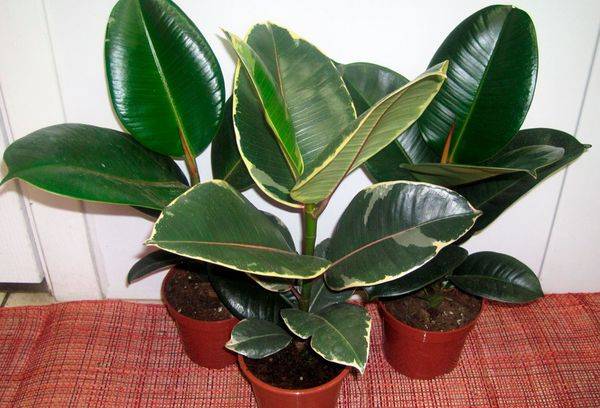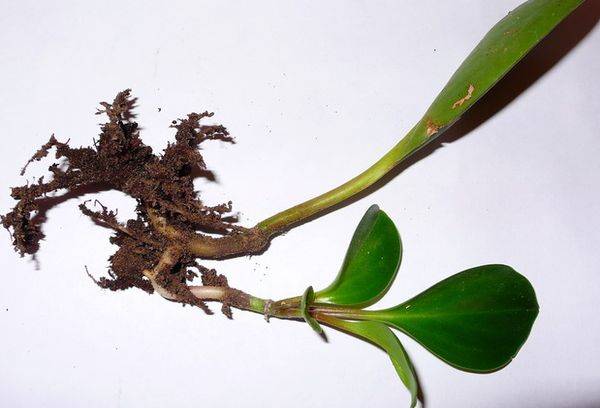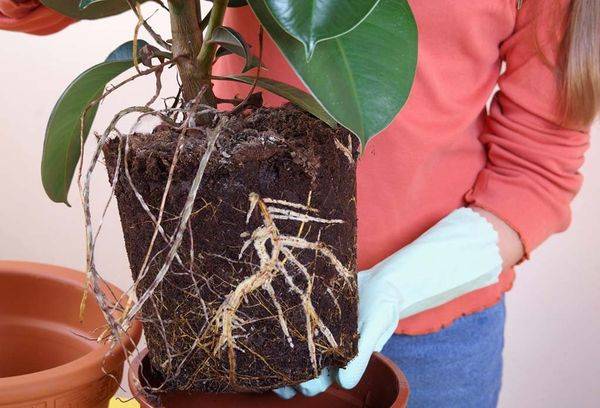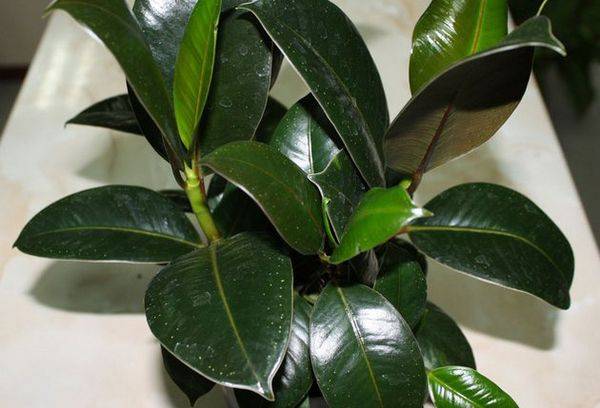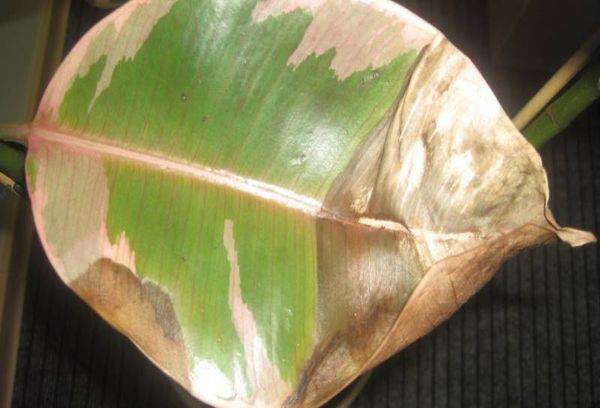We grow rubber ficus on your windowsill
Content:
A wonderful combination of beautiful appearance with a touch of exoticism and unpretentiousness in care. Meet: in front of you is a representative of the plant world of tropical Asia - rubber ficus. Initially, this plant was brought to Europe for industrial cultivation, that is, the development of rubber, where the name came from. Subsequently, the flower won the hearts of gardeners. He still has not lost his popularity and occupies a worthy place in home flower collections.
Characteristic
Rubber ficus has two more names: rubber ficus and elastic ficus (lat. Ficus elastica). This plant is a species of the genus Ficus of the Mulberry family. His homeland is the tropics of Asia. This species grows in the tropical forests of India and the Indonesian islands of Sumatra and Java. However, in the wild, the appearance of the plant is significantly different from how we are used to seeing it. On average, in the natural habitat, the ficus reaches a height of 30 m. The thickness of the trunk varies from 1 to 2 m, and the length of the leaf plate is 25-30 cm.
At home, ficus grows no more than 2 m in height. But the plant is characterized by rapid development. Typically, a rubber tree adds 40-50 cm in growth annually. Shrub formation is one of the main tasks in caring for a plant. To limit its growth, you have to pinch the top. After this, the ficus begins to form lateral shoots and grow in width.
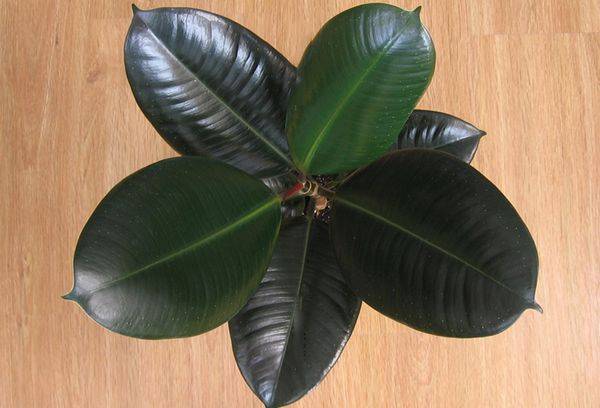
Ficus Abidjan
Flowering in room conditions is almost impossible to achieve. This requires pollination by insects living in the homeland of ficus. The beauty of the plant lies in oval glossy leaves with a pointed edge. They perfectly decorate both the house and the office. Leaves also form with rapid speed: from spring to autumn, under comfortable conditions, a tree grows one new leaf per week. In this case, the old leaves remain in place.
Varieties
Rubber-bearing ficus is known for a wide variety of varieties that differ in leaf size and color. For indoor growing, the following are suitable:
- Belize - the owner of leaves painted in three colors at once. In the center, the leaf plate is green, and along the edges it is decorated with pink and white stains. Ficus is easy to maintain, the main requirement is good lighting.
- Robusta - the most popular variety. Its leaves are wide, glossy, saturated dark green. In leaving unpretentious.
- Melanie - miniature ficus. Good bush.
- Tineke - one of the variegated varieties. Most demanding on lighting. With a lack of light, it becomes covered with brown spots.
- Black Prince - the owner of dark, almost black shiny leaves. It is recommended to place it in the interior, where light colors prevail.
- Abidjan - ficus with dark leaves decorated with a burgundy vein.
- Lyre-shaped - Ficus variety, leaf shape resembling lyre. Grows slower than other varieties.
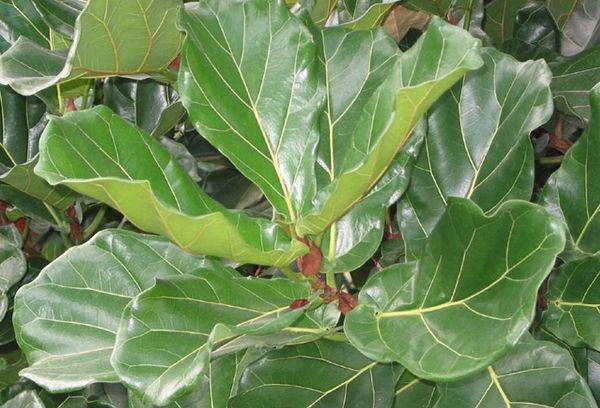
ficus lyre-shaped
Care
Rubber ficus is a hardy plant that can forgive some inattention to itself. This flower will grow even a novice grower, resulting in a strong and beautiful tree. The rules of care include compliance with temperature, humidity, lighting. Depending on the variety, some indicators may vary.
Like most tropical plants, rubbery ficus loves diffused light. Direct sunlight is dangerous for leaf blades: burns can form on them. The best place would be a window sill with a curtain on the window.
Tip
If ficus is grown on the north side, shading is not necessary.
Ficus exists well in partial shade, but its development will proceed more slowly than usual, and over time the lower leaves will begin to turn yellow and fall. Variegated sheet plates are more demanding on lighting. With its deficiency, they can lose the saturation of the shade.
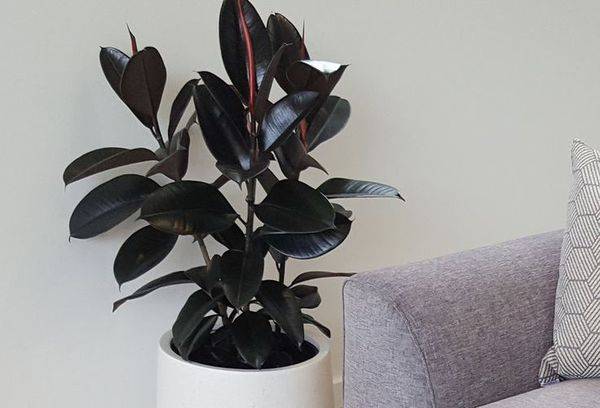
Ficus Black Prince
Ficus loves warmth. In summer, the optimum temperature is from +18 to + 24⁰ C. In winter, the plant will be comfortable at a temperature of + 16-18⁰. The lower limit for variegated varieties is 12 degrees Celsius, if the thermometer goes down, the plant will drop its leaves. And ficuses with ordinary leaves can withstand short-term temperature drops of up to + 5⁰C, while the soil should remain warm.
Although the plant is fairly stable, temperatures below normal are stressful for it. Better not let the tree freeze if you want to maintain its beautiful appearance. Rubber-bearing ficus does not tolerate drafts. If the flower gets under the stream of air and the soil is moist, there is a high probability that it will drop leaves or become covered with brown spots.
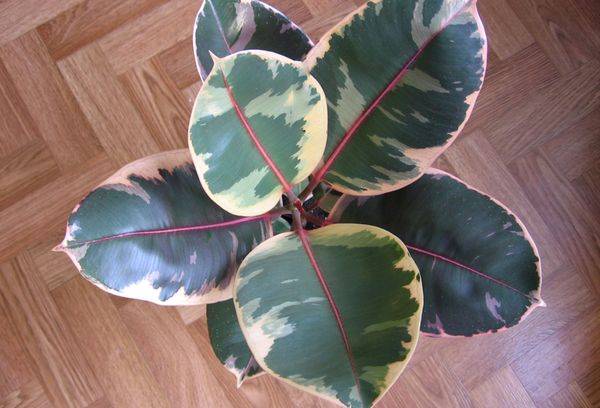
Ficus Belize
Watering and humidity, fertilizers
Ficuses with large leaves are not demanding on air humidity; they are comfortable in normal room conditions with medium humidity. Only on hot days do they need spraying. Water for this procedure is taken boiled or bottled. In winter, spraying will also be useful - if the plant is near the battery or in the apartment too dry air. A sign of insufficient moisture is the dry tips of the leaves.
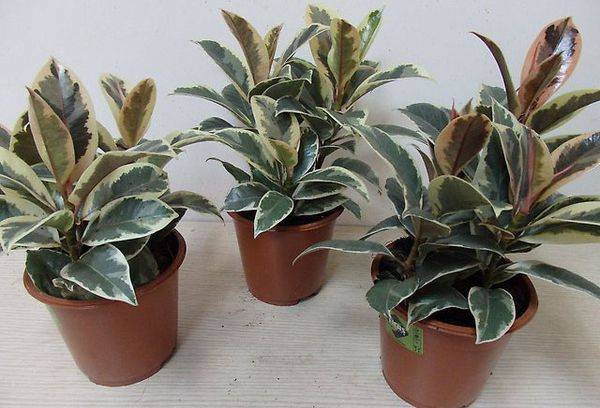
Ficus Tineke
Watering should be regular, but moderate. Excess, as well as lack of water, often leads to dropping leaves. purityis.decorexpro.com/en/ recommends pouring rubbery ficus with warm, settled water, keeping the soil slightly moist. In the summer, two waterings per week are sufficient; in the winter, hydration is reduced to two to three times a month.
Periodic water procedures in the form of a warm shower will not damage the ficus. The soil in the pot must be covered with plastic wrap. In summer, it is recommended to wipe the ficus leaves with a damp sponge once every two weeks. In winter, rubbing the leaves is preferable to spraying them.
From April to September, when the tree is actively growing, it is allowed to feed it with minerals. Fertilizers are applied twice a month. Alternate liquid mineral fertilizer with organic.
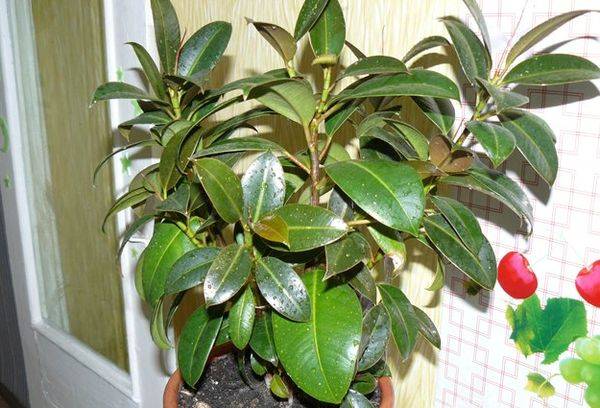
Ficus Melanie
Important
The nutrient should not get on the leaves and sprouts.
Feeding example:
- pour the pre-moistened soil with a solution of nitrophoska (for 1 liter of water - 1 teaspoon);
- two weeks later, “treat” the ficus with the infusion of mullein, also introducing it into moist soil.
Only adult, well-rooted plants should be fertilized. Some gardeners like to “polish” ficus leaves.
Tip
Do not use harmful chemicals for this purpose. Non-alcoholic beer is more suitable as a polish.
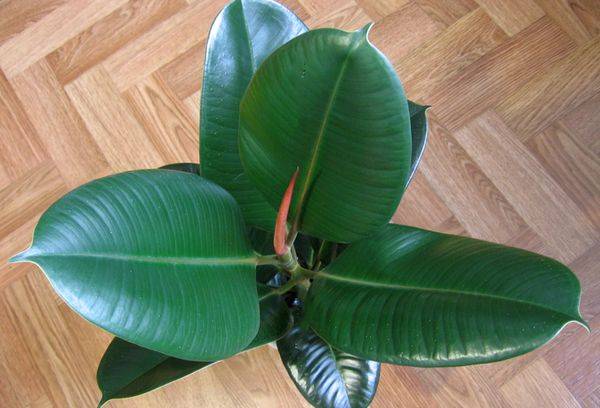
Ficus Robusta
Breeding
Reproduction of rubber ficus occurs in two ways:
- cuttings
- air layering.
The apical stalk is cut with a sharp knife. Before rooting, you need to substitute the shank under a stream of water and wait until the milky juice ceases to stand out. Now he is ready to take root, both in water and in the ground. At the time of strengthening in the substrate, it is better to cover the container with polyethylene.
The rooting of cuttings of green-leaf varieties is not difficult. With variegated is more difficult: they will need the introduction of stimulants. Rooters “Kornevin” or “Heteroauxin” are suitable. They handle the tip of the handle before planting.
It is better to propagate variegated varieties by air layering:
- make an incision on the trunk with a depth of 1/3 of its thickness;
- insert a match into the notch so that it does not overgrow;
- wrap part of the trunk with a notch with wet sphagnum moss;
- now wrap the barrel with polyethylene, and secure it, for example, to tape;
- soon through a transparent film it will be noticeable that the ficus has released its roots;
- cut the shoot below the layering with the roots and plant.
Transplant, cropping and shaping
What soil does the ficus prefer? It should be loose, nutritious, good air and moisture. Periodically, it is necessary to loosen the sagging soil so that a lump does not form. Ready-made substrate for growing is sold in stores. To make it yourself, prepare in equal parts:
- humus,
- peat,
- leaf and turf land,
- sand.
Ficus does not need frequent transplants. Young trees are resettled once a year, adults - once every three years. A sign that the plant is cramped in the old pot are sticking roots. The time for transplanting is the beginning of spring. Do not forget to put in a new container a drainage layer of expanded clay or small shards. The plant should be carefully moved to a new place of residence without damaging the root system. It will also be beneficial to replace the topsoil with fresh once a year.
So that the plant does not swing under the ceiling, do not plant it in a large pot. Trimming and bush formation also limit its growth. It is necessary to form a ficus in order to form lateral shoots, and the tree was more magnificent.
How to form a neat tree:
- Proceed better in late winter or early spring. At this time, the plant branches well, and the release of toxic juice is minimal.
- Pruning is done before transplanting, in about 2-4 weeks.
- The trimming tool is disinfected in alcohol.
- A branch with 3-5 internodes is cut. A sharp knife or blade is used.
- To shorten the side shoots, cuts are made above the kidneys. You can cut both at an angle and directly. The direction of kidney growth is strictly outward.
- Cut points are treated with charcoal.
Disease and treatment
What diseases and other troubles are encountered when growing ficus:
- Defeat with a scab. Symptoms: sticky spots and spots on the leaves. A solution of tobacco with soap will help. A parasite damages a plant that is not kept clean.
- Defeat with a spider mite. Symptom: leaves change color, fade and fall. All leaf plates need to be treated with tobacco infusion. Humidity is necessarily regulated in the room, as the parasite appears in an excessively warm and dry place.
- A tree in a draft will almost certainly attract a mealybug. Symptoms: white clusters form on the leaves. Treatment - double treatment with an insecticide (second treatment - after 7 days).
- Leaves turn yellow and fall. The reason is either an excess or lack of moisture in the soil. Try increasing the amount of light.
- Fungal diseases affect ficus growing in a room with poor ventilation.
- Growth arrest occurs in low light, a cramped pot and a lack of nutrients.
Interesting Facts
What is more interesting rubbery ficus:
- Ficus is a symbol of family well-being.
- In Buddhists, the plant is sacred.
- In the 20th century, the rubber ficus was unacceptable for a self-respecting citizen of the Soviet Union. This plant was considered a sign of philistinism.
- Thick plant juice contains a large amount of rubber. This substance is used to make rubber.
- The juice contains alkaloids and enzymes that are toxic to humans and animals. White droplets sometimes appear directly on the surface of the sheet. Touching the juice with unprotected skin sometimes causes an allergic reaction. But for the plant itself, its juice is medicinal: it heals cracks and cuts, protects against pests.
- Close relatives of the rubber ficus - ficus microcarp, Benjamin, binnendika (loosestrife), Bengali, sacred, dwarf.
- In the wild, the tree grows many aerial roots that provide additional nutrition. Due to the impressive appearance among the local population, the plant has the nickname "snake tree".
- According to the horoscope, rubber ficus is suitable for Leo and Capricorn.
- The Hindus are building with his help "living bridges", supporting the weight of 50 people.
These are not all the amazing facts about rubbery ficus. The ficus tree fits well into any interior and does not require special ceremonies, which gives reason to start growing it right now.
